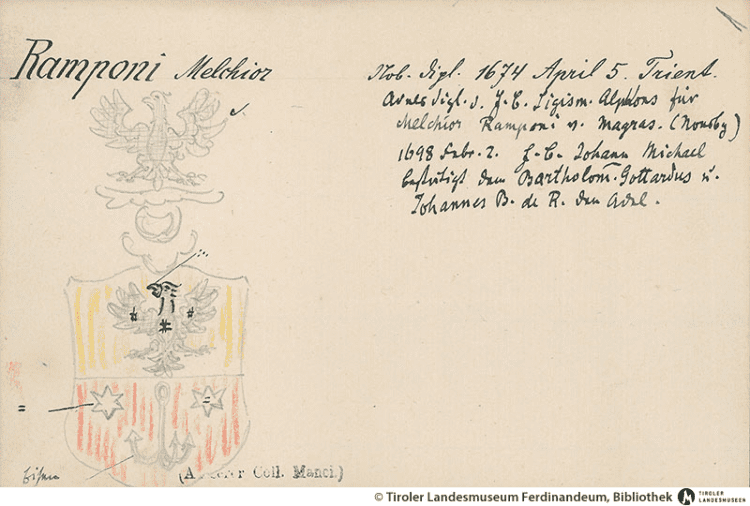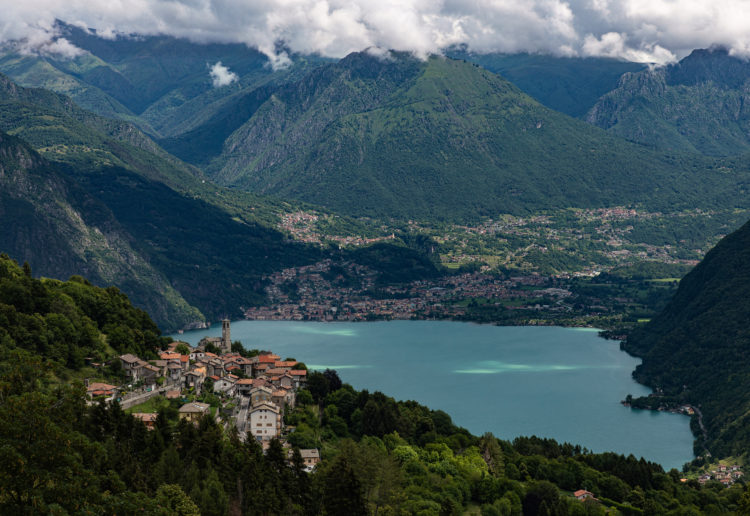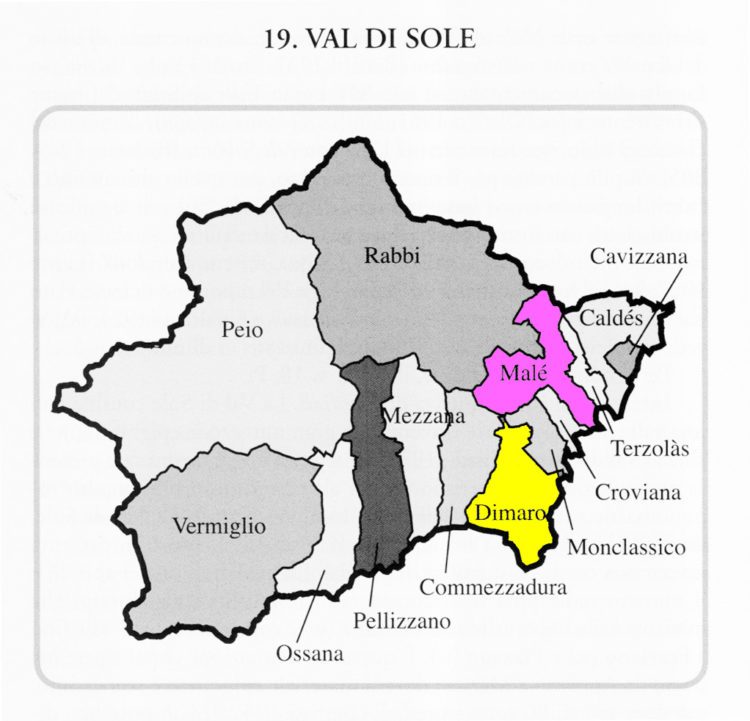Brief overview of the early Ramponi families in Dimaro, Carciato and Magras in Val di Sole. By genealogist Lynn Serafinn
Want to keep this article to read offline? You can purchase it as an 8-page printable PDF, complete with clickable table of contents, colour images, charts, footnotes and resource list.
Price: $0.99 (99 cents) USD.
Available in Letter size or A4 size.
Origins
Variants: Rampon; Ramponi Von Magras und Rosenhof; Ramponi di Rosenhoff
Ramponi is a toponymic surname derived from name of the frazione of Ramponio (now part of the municipality of Alta Valle Intelvi) in the province of Como in Lombardia, where the family were documented as having been citizens in 1417.[1] The surname is found in many parts of Italy, but it is most prominent in its native region of Lombardia. In Trentino, it is found most prominently in Val di Sole.[2]
Panoramic view of Ramponio Verna in Lombardia.[3]
The Early Ramponi of Dimaro and Carciato
A branch of the Ramponi had already settled in Trentino – more precisely, in Dimaro in Val di Sole – by the end of the 1400s. Historian Udalrico Fantelli tells us that the first document we find with this surname in Dimaro is dated 8 March 1505, in the house of a Ser Giovanni, son of the late Tomeo Rampon’.[4]
Map of the comune in Val di Sole (drawn in 2003).
Carciato is included as part of Dimaro, and Magras is part of Malé.[5]
Fantelli cites several other early documents from Dimaro containing references to the Ramponi, including a list of several Ramponi men who were included amongst the regolani (those entitled to have a say in local law-making decisions) for Dimaro in 1565. One of these, a Giovanni, son of the late Simone Ramponi, was the saltaro, which is the man responsible for calling together the meetings of the regolani. In later decades, we find a Simone Ramponi cited as being a senior regolano.[6]
By the early 1600s, we find branches of the Ramponi also living in the frazione of Carciato. Fantelli tells us that there were at least 42 Ramponi births in the parish in the 1600s, with another 39 the following century.[7]
In 1750, one Stefano Ramponi was among the heads of households who had sanctioned the construction of the new chapel of San Giovanni Battista in Carciato.[8]
The Early Ramponi of Magras
As Dimaro is a curate church of the deanery of Malé, you will occasionally find some early Dimaro Ramponi appearing in the Malé baptismal register. However, by the middle of the 1500s, we also find a few Ramponi households living in Magras (a frazione of the parish of Malé). It is unclear as to whether the heads of household in that era were born in Magras or had moved there from Dimaro as adults.
The Noble Line of Melchiore Ramponi of Magras
Among these early Magras households was one ‘Ser’ Melchiore Ramponi (likely born around 1515-1520), who fathered at least three sons and one daughter with his wife Anna. Although already ennobled in some form at least since the mid-1500s, his descendants would go on to receive many additional noble titles throughout the centuries. His great-grandson, also named Melchiore,[9] was awarded episcopal nobility by Prince-Bishop Sigismondo Alfonso Thun on 5 April 1674,[10] [11] and was granted the use of this stemma:[12]

This Melchiore fathered at least 14 children with his wife, the noble lady Andreana Campi.[13] Melchiore died at the age of 64 on 23 May 1676.[14] Some years later, on 20 April 1694, the Prince-Bishop issued confirmation of Melchiore’s noble privileges to his three sons, Bartolomeo, Gottardo, and Giovanni Battista.[15]
Of these brothers, Gottardo and Giovanni Battista remained in Magras after marriage, both fathering large families. Gottardo married the noble lady Margherita Zini of Cavareno,[16] and we also know from many documents (including his death record) that his brother Giovanni Battista was a medical doctor.[17] The eldest brother, Bartolomeo, appears to have spent most of his adult life outside Magras. We do find one daughter born to him and his wife Lucrezia in Magras in 1664,[18] but then we see nothing more about him until the death of Lucrezia. Lucrezia’s death record, (dated 27 October 1671), says she died in Mezzolombardo, but was buried in the Ramponi family tomb in Magras.[19] Although I have not yet consulted the Mezzolombardo registers, as we know Bartolomeo lived until at least 1698 (and there is no death record for him in the Malé register), I think it likely that he lived out his days in Mezzolombardo, or perhaps in Austria. Moreover, I am also reasonably confident he remarried, and that he had a daughter named Giovanna Claudia, who returned to Magras where she was married three times.[20] There are two Ramponi births listed in Mezzolombardo in the early 1800s, but I don’t know if or how they are connected to this line.
Ramponi Notaries
At least three Ramponi men served as notaries in the 18th century, all from Magras.
Born 27 Feb 1716, Gottardo Paolo (grandson of Gottardo Ramponi and Margherita Zini),[21] worked as a notary at least between from 1743 until his death on 23 July 1759.[22] [23] We learn from his death record and from the baptismal of one of his children[24] that he was also the ‘Vicario of Rabbi’. Gottardo Paolo’s son, Carlo Stanislao Alessio Ramponi, whom we will return to shortly, carried on his father’s profession as a notary.
Another Ramponi notary was one Simone Ramponi, who served as a notary as early as 1705, until his untimely death at age 39 on 27 January 1719. Simone was the second husband of the above-mentioned Giovanna Claudia Ramponi. Although he appears to have been the great-great-grandson of the early Melchiore, the couple did not require a dispensation to marry, which shows they were not closely related.[25]
Early Ramponi Priest from Magras
Within the earliest records for the parish of Malé, we find the baptism of a Giovanni Ramponi, son of Antonio Ramponi and his wife Matiola, who was born in Magras on 13 April 1565.[26] Giovanni, who grew up to become a Catholic priest, served as the parroco of the parish of Sanzeno from 1602 to 1623, and was also the dean of Val di Non from 1603.[27] [28]
Imperial Nobility and Extinction of the Line in Magras
Two of the great-grandsons of Gottardo Ramponi and Margherita Zini were granted Imperial nobility. On 4 December 1783, brothers Giuseppe Melchiore Ramponi (a medical doctor and professor in medicine) and Carlo Stanislao Ramponi (doctor in Law and notary) were elevated to the rank of Knights of the Holy Roman Empire, and given the predicate ‘Von Magras und Rosenhof’[29], sometimes simplified to ‘Ramponi di Rosenhoff’.[30]
Although one branch of this family is said to have transferred to Vienna in the 1700s,[31] the line in Magras is now extinct. The last birth Ramponi birth in the Magras or Malé records is dated 31 December 1798, and was for a Maria Cecilia, daughter of Carlo Ramponi and his wife Lucrezia Costanzi. Sadly, Carlo died a few months before his daughter’s birth; he was only 22 years old when he died, leaving behind no sons to carry on the surname. [32]
Ramponi in Trentino Today
The Nati in Trentino website lists 252 Ramponi births between the years 1815-1923, nearly all of which (239) took place in the parish of Dimaro.[33] There were 11 Ramponi births recorded in the parish of Malé in the late 19th century, but these were all the children (and a grandchild) of Michele Ramponi, a lawyer from Carciato.[34]
The index of the digitised portion of the Dimaro baptismal register lists Ramponi births through 1939, but we know there are still many Ramponi living in Dimaro today, as they make up the majority of the estimated 52 Ramponi families currently living in Trentino.[35]
I hope you enjoyed this brief overview of the early Ramponi of Val di Sole. If you would like to keep this article to read offline, you can purchase it as an 8-page printable PDF, complete with clickable table of contents, colour images, charts, footnotes and resource list.
Price: $0.99 (99 cents) USD.
Available in Letter size or A4 size.
If you have any comments or questions, or if you are seeking help researching your Trentino family, please feel free to contact me at https://trentinogenealogy.com/contact.
Until next time!

Warm wishes,
Lynn Serafinn
25 April 2023
P.S. I am currently taking client bookings for JULY 2023 and beyond. If you would like to book a time to discuss having me do research for you, I invite you to read my ‘Genealogy Services’ page, and then drop me a line using the Contact form on this site. Then, we can set up a free 30-minute chat to discuss your project.
Join our Trentino Genealogy Group on Facebook: http://facebook.com/groups/TrentinoGenealogy
Lynn on Twitter: http://twitter.com/LynnSerafinn
View my Santa Croce del Bleggio Family Tree on Ancestry:
https://trentinogenealogy.com/my-tree/
NOTES
[1] TABARELLI DE FATIS, Gianmaria; BORRELLI, Luciano. 2005. Stemmi e Notizie di Famiglie Trentine. Trento: Società di Studi Trentini di Scienze Storiche, page 263.
[2] COGNOMIX. ‘Ramponi’. Mappe dei cognomi italiani. https://www.cognomix.it/mappe-dei-cognomi-italiani/RAMPONI/. Accessed 24 April 2023.
[3] Photo by Maurizio Moro5153 – Own work, CC BY-SA 4.0, https://commons.wikimedia.org/w/index.php?curid=94363015. Accessed 20 April 2023 from article ‘Ramponio Verna’ on Wikipedia at https://en.m.wikipedia.org/wiki/Ramponio_Verna/
[4] FANTELLI, Udalrico. 1990. Dimaro: la carta di regola. Centro Studi per la Val di Sole, page 83.
[5] ANZILOTTI, Giulia Mastrelli. 2003. Toponomastica Trentina: i nomi delle località abitate. Trento: Provincia autonomia di Trento, Servizio Benni librari e archistici, page 379. I have added highlights in Photoshop.
[6] FANTELLI, Udalrico. 1990. Dimaro: la carta di regola. Centro Studi per la Val di Sole, page 84.
[7] FANTELLI, Udalrico. 1990. Dimaro: la carta di regola. Centro Studi per la Val di Sole, page 85.
[8] FANTELLI, Udalrico. 1992. Carciato: il paese e la gente. Centro Studi per la Val di Sole, page 64.
[9] The younger Melchiore was born 11 November 1608. Malé parish records, baptisms, volume 2, page 98. His father was Gottardo, who was the son of the elder Melchiore’s son, Bartolomeo.
[10] TABARELLI DE FATIS, Gianmaria; BORRELLI, Luciano. 2005. Stemmi e Notizie di Famiglie Trentine. Trento: Società di Studi Trentini di Scienze Storiche, page 263.
[11] GUELFI, Adriano Camaiani. 1964. Famiglie nobili del Trentino. Genova: Studio Araldico di Genova, page 101.
[12] TIROLER LANDESMUSEEN. Tyrolean Coats of Arms. Stemma of Melchiore Ramponi. http://wappen.tiroler-landesmuseen.at/index34a.php?wappen_id=22465&drawer=&tr=1#prev
[13] Neither their marriage record nor Andreana’s baptismal record is in the Malé register. I suspect she may have been from Denno or Campodenno, but sadly the early records for those parishes were destroyed in a fire in 1736.
[14] Malé parish records, deaths, volume 1, page 52-53.
[15] Apparently, this confirmation was originally granted by Prince-Bishop Giuseppe Vittorio Alberti di Enno, who died the following year, and then it was reconfirmed on 2 February 1698 by his successor Giovanni Michele Spaur. TABARELLI DE FATIS, Gianmaria; BORRELLI, Luciano, page 263. And GUELFI, Adriano Camaiani, page 101.
[15] Malé parish records, deaths, volume 1, page 52-53.
[16] Gottardo Ramponi and Margherita Zini married in Cavareno on 9 February 1665 (Sarnonico parish records, marriages, volume 2, page 151-152). The couple were granted a dispensation for 4th grade consanguinity (meaning they were 3rd cousins) but lack of records makes it impossible for me to identify their common ancestor(s).
[17] Malé parish records, deaths, volume 2, page 28-29.
[18] Andreana Ramponi, daughter of Bartolomeo Ramponi and his wife Lucrezia, was born in Magras on 31 July 1664. Malé parish records, baptisms, volume 3, page 29.
[19] Malé parish records, deaths, volume 1, page 42-43.
[20] Giovanna Claudia’s birth is not recorded in the Malé register, nor is her father’s name mentioned in any of her marriage records. Her first husband, Giovanni Francesco Carelli died 3 November 1712. Her second husband, Simone Ramponi, died 27 January 1719. Her third husband was Giovanni Slucca (married 10 April 1720). I am presuming she was the daughter of Bartolomeo, partially because she had a son of this name, and partially because there are no gaps big enough in the births of the children of Bartolomeo’s brothers during which time she could have been born.
[21] Malé parish records, baptisms, volume 4, page 121.
[22] STENICO, P. Remo. 1999. Notai Che Operarono Nel Trentino dall’Anno 845. Trento: Biblioteca San Bernardino, page 287.
[23] Malé parish records, deaths, volume 2, page 96-97.
[24] The reference is in the baptismal record of Giovanni Ernesto Gottardo Ramponi, born 27 May 1748. Magras parish records, baptisms, page 1.
[25] Lack of records make it difficult to piece together the precise connection, but my theory is that they may have been 3rd cousins 1X removed. Relationships further than 4th grade consanguinity (3rd cousins) did not require a church dispensation.
[26] Malé parish records, baptisms, volume 1, page 82.
[27] WEBER, Simone (Mons.). 1992 (reprint). Le Chiese delle Val di Non Nella Storia e Nell’Arte. Volume III: I Decanati di Taio, Denno e Mezzolombardo. Mori (Trento): La Grafica Anastatica, page 49.
[28] STENICO, P. Remo. 2000. Sacerdoti della Diocesi di Trento dalla sua Esistenza Fino all’Anno 2000. Indice Onomastico, page 356. Stenico lists him but gives no details.
[29] TABARELLI DE FATIS, Gianmaria; BORRELLI, Luciano. 2005. Stemmi e Notizie di Famiglie Trentine. Trento: Società di Studi Trentini di Scienze Storiche, page 263.
[30] GUELFI, Adriano Camaiani. 1964. Famiglie nobili del Trentino. Genova: Studio Araldico di Genova, page 101.
[31] TABARELLI DE FATIS, Gianmaria; BORRELLI, Luciano. 2005. Stemmi e Notizie di Famiglie Trentine. Trento: Società di Studi Trentini di Scienze Storiche, page 263. I presume both of the brothers who obtained Imperial nobility are the ones who relocated, as I have not found their death records in the registers for Magras or Malé.
[32] Carlo Luigi Antonio Ramponi died on 16 August 1798. Magras parish records, deaths, volume 1, no page number.
[33] NATI IN TRENTINO. Provincia autonomia di Trento. Database of baptisms registered within the parishes of the Archdiocese of Trento between the years 1815-1923. https://www.natitrentino.mondotrentino.net/.
[34] Dated 29 May 1872, the baptismal record of Sisinio Stefano Pietro Ramponi (born in Malé) says his father was ‘Signore Michele (Ramponi) of Carciato, Doctor of Law, and collaborator with Signore Doctor Bontempelli, lawyer in Malé, and son of the late Stefano (Ramponi) and Luigia Largajolli.’ Malé parish records, baptisms, volume 9, page 89. We find a child of this Sisinio born in Malé in 1901.
[35] COGNOMIX. ‘Ramponi’. Mappe dei cognomi italiani. https://www.cognomix.it/mappe-dei-cognomi-italiani/RAMPONI/. Accessed 24 April 2023.



